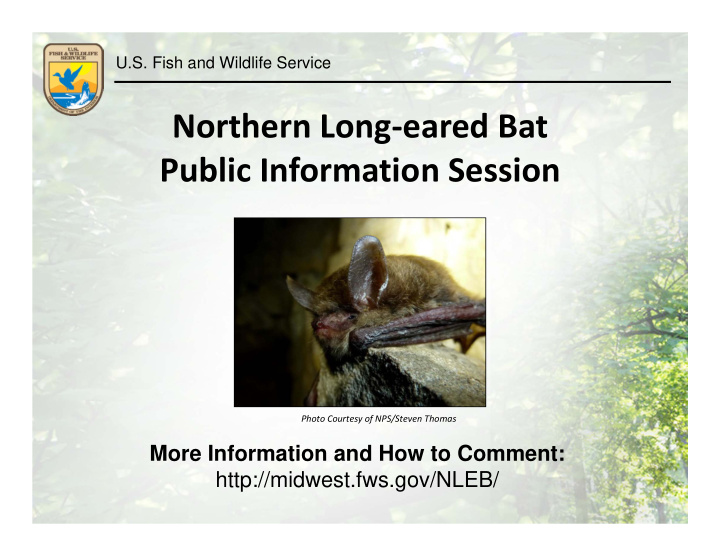



U.S. Fish and Wildlife Service Northern Long ‐ eared Bat Public Information Session Photo Courtesy of NPS/Steven Thomas More Information and How to Comment: http://midwest.fws.gov/NLEB/
U.S. Fish and Wildlife Service Agenda • Why the Service Proposed Listing • Northern Long ‐ eared Bat Habitat Needs • White ‐ nose Syndrome as Primary Threat • Other Sources of Mortality • Making a Final Decision • Your Questions
U.S. Fish and Wildlife Service Bats Are Important • Bats are a vital part of a healthy environment • Bats eat insects that are pests to crops and humans • Research suggests bats save the agriculture industry more than $3 billion in pest control per year. • Study of bats has led to advancements in science and medicine.
U.S. Fish and Wildlife Service The northern long ‐ eared bat is in trouble. We, and our partners, are trying to keep it from going extinct.
U.S. Fish and Wildlife Service Timeline: Proposal to List Northern Long ‐ eared Bat October 2013: June 2014: Proposed listing 6 ‐ month April 2, 2015: August 29, 2014: January 2010: published; extension on final Final Comment period Petitioned to list 60 ‐ day comment decision; determination closes period (extended comment period expected to 90 days) re ‐ opened
U.S. Fish and Wildlife Service Northern Long ‐ eared Bat
U.S. Fish and Wildlife Service Northern Long ‐ eared Bat Habitat Needs Summer • Roosts and forages in forested habitat Fall • Typically migrate 50 miles from summer habitat to hibernacula Winter • Hibernates in caves, mines, tunnels and similar structures
U.S. Fish and Wildlife Service
U.S. Fish and Wildlife Service White ‐ nose Syndrome is Primary Threat • Infectious disease responsible for deaths of millions of bats in eastern North America • In some Northeast caves, northern long ‐ eared bat has declined by up to 99%
White ‐ nose Syndrome Occurrence in North America 2007
White ‐ nose Syndrome Occurrence in North America August 2014
U.S. Fish and Wildlife Service Working Together to Help the Northern Long ‐ eared Bat • White ‐ nose Syndrome National Team • Habitat conservation plans • Research on: – forest management – bat migration – population trends • Information and education Photo courtesy Steven Taylor/University of Illinois
U.S. Fish and Wildlife Service Making a Final Decision • Must be based “solely on the basis of the best scientific and commercial data available” • Current public comment period closes August 29, 2014 • We are seeking public comment and working with states, Tribes and other federal agencies • We will fully consider all written comments and any additional information we receive • Final decision expected April 2, 2015
U.S. Fish and Wildlife Service More Information and How to Comment: http://midwest.fws.gov/NLEB/ Points of Contact • Georgia Parham • Meagan Racey (IA, IL, IN, MI, MN, MO, OH, WI) (CT, DE, ME, MD, MA, NH, NJ, NY, 812 ‐ 334 ‐ 4261 x 1203 PA, RI, VT, VA, WV, and DC) Georgia_Parham@fws.gov 413 ‐ 253 ‐ 8558 Meagan_Racey@fws.gov • Lesli Gray (AZ, NM, OK, TX) • Leith Edgar 972 ‐ 569 ‐ 8588 (CO, KS, MT, NE, ND, SD, UT, WY) Lesli_Gray@fws.gov 303 ‐ 236 ‐ 4588 Leith_Edgar@fws.gov Jennifer Strickland • (AL, AR, FL, GA, KY, LA, MS, NC, SC, TN) Catherine Hibbard • 404 ‐ 679 ‐ 7299 WNS Nationwide Jennifer_Strickland@fws.gov 413 ‐ 253 ‐ 8569 Catherine_Hibbard@fws.gov
Recommend
More recommend